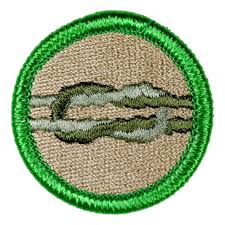Back to T110 Home Page
KNOT-TYING
has long been a part of the Scouting program - for good
reasons. It promotes discipline and focus, and it teaches
useful skills that can be used immediately. Most people can
tie just one knot (the "overhand"); many Scouts know more
than a dozen. Here's
how to teach these knots to Scouts and
Venturers. (After
viewing a video, click on the back arrow of your browser to
return to this page. The videos posted on this page are ad
free.) SHEET
BEND AND DOUBLE SHEET BEND Need
to tie two ropes together? This is the knot for you.
The sheet bend won't slip when ropes of dissimilar
material and size are entwined. When
tying the knot, be sure that the working ends are on the
same side; otherwise, the knot might be unreliable. If you
tie a thick and thin rope together, use the thick rope to
form the "stationary loop" and the thin rope as the "working
line." For
greater security, especially with plastic rope, use the
"double sheet bend" by taking an extra coil around the
standing loop. The double sheet bend can be used
when you've tied two ropes together and the knot absolutely
must not fail. How
To Video:
SheetBend.mp4
| How
To Video:
DoubleSheetBend.mp4 BOWLINE This
knot is popular among mountaineers, climbers, sailors and
others. Use the bowline when you need a non-slip
loop at the end of a line. The knot won't slip, regardless
of the load applied. Begin
by forming a loop or "rabbit hole." The "rabbit" (working
end) of the rope goes up through the hole, around the tree,
then back down the hole. The knot will slip as it tightens,
so allow a long working end. How
To Video:
BowlineKnot.mp4 TRUCKER'S HITCH The trucker's
hitch is a powerful pulley with a locking knot. Use
this when you need a locking pulley with a 2-to-1 mechanical
advantage, such as hanging a bear bag, tying a canoe on a
car or guying out a tarp. Unlike the taut-line hitch, this
knot won't slip when used with slippery line. Form
the overhand loop. Then pull the loop through. Make the loop
exactly as shown in the video; it won't work if you do it
backwards. Run the working end of the rope through the loop
and then pull hard to form the pulley. Secure
the pulley to a stationary object (like a pole or branch)
with a quick-release half-hitch or, for extra security, two
or more standard half-hitches. How
To Video:
TruckersHitch.mp4 TWO
HALF-HITCHES Use
two half hitches to tie a rope to a tree, ring or
dock. If
you need more security, take a second turn around the tree,
or just add more half-hitches. How
To Video:
TwoHalf-Hitches.mp4 TAUT-LINE
HITCH To
create an adjustable loop that stays in place, use
the taut-line hitch. This is the knot to use for
staking out the guy lines of your tent. How
To Video:
Taut-LineHitch.mp4 PRUSIK
HITCH A prusik
hitch can slide up or down a stationary rope, but it
will hold fast when weight is applied. It's used in a number
of self-rescue situations. Mountaineers use the prusik for
footholds to help them climb a vertical rope. Campers use it
for rigging rain flies or rescuing rock-pinned canoes in a
river. First,
use a sheet bend or double fisherman's knot (instructions
below) to make a loop from a length of parachute cord or
rope. Then,
wrap the loop around the main line three times.
The prusik hitch will slide easily along the rope,
but it will jam when a load (horizontal or vertical) is
applied. How
To Video:
PrusikHitch.mp4 DOUBLE
FISHERMAN'S KNOT Use
this knot to tie together the ends of one rope, forming a
loop. The loop of rope can be used for many purposes,
including the prusik hitch, shown above. How
To Video:
DoubleFishermansKnot.mp4 CLOVE
HITCH The clove
hitch is a versatile knot that is often used in
Scouting activities, including serving as the start or
finish to many lashings. How
To Video:
CloveHitch.mp4 SQUARE
KNOT The square
knot can be used to join two ropes together. Generally,
it works best with two ropes of the same diameter, and
should not be used to hold a heavy load. How
To Video:
SquareKnot.mp4 TIMBER
HITCH The timber
hitch is often used to drag a log across the ground or
to start a diagonal lashing. How
To Video:
TimberHitch.mp4![]()
~
Scouting Knots ~
 How
To Tie 10 Essential Scouting Knots -
Videos
How
To Tie 10 Essential Scouting Knots -
Videos
By Cliff Jacobson
Photographs by W. Garth Dowling
From the May-June
2016 issue of Scouting Magazine
Top
![]()